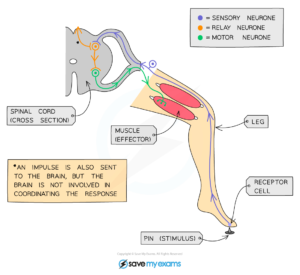A reflex action is an involuntary and almost immediate response to a stimulus, which occurs without conscious thought. Reflexes are important for protecting the body from harm and for maintaining homeostasis. The reflex action pathway involves the reflex arc, which is a simple neural pathway that allows for rapid responses to stimuli.
Characteristics of Reflex Actions:
- Involuntary: Reflex actions occur automatically, without conscious thought or effort.
- Fast: Since reflex actions don’t require processing by the brain (in many cases), they happen almost immediately.
- Protective: Reflex actions often help prevent injury or harm by rapidly responding to potentially harmful stimuli.
Example of a Reflex Action:
One of the most well-known reflexes is the knee-jerk reflex (patellar reflex), which occurs when a tendon just below the kneecap is tapped.
Reflex Arc:
The reflex action involves the reflex arc, which is the neural circuit that carries the signal and causes the reflex. It consists of the following steps:
-
Receptor:
- The receptor is the sensory organ (e.g., skin, eyes) that detects the stimulus. For example, in the knee-jerk reflex, the receptor is the sensory nerve in the patellar tendon that detects the tap.
-
Sensory Neuron:
- The sensory neuron carries the information from the receptor to the spinal cord. The neuron enters the spinal cord through the dorsal root.
-
Interneuron (in the spinal cord):
- In simple reflexes, the sensory neuron directly synapses with a motor neuron in the spinal cord. However, in more complex reflexes, the sensory neuron synapses with an interneuron (a neuron that connects sensory and motor neurons) to integrate the information.
-
Motor Neuron:
- The motor neuron carries the signal from the spinal cord to the effector, which is the muscle or gland that responds. The motor neuron exits the spinal cord through the ventral root.
-
Effector:
- The effector is the muscle or gland that produces the response. In the knee-jerk reflex, the effector is the quadriceps muscle in the thigh, which contracts and causes the leg to extend.
Example of Reflex Action:

- Knee-Jerk Reflex:
- A tap on the patellar tendon stretches it.
- The stretch is detected by sensory receptors in the muscle spindle.
- The sensory neuron carries this information to the spinal cord.
- The sensory neuron directly synapses with a motor neuron in the spinal cord (in this simple reflex, no interneuron is involved).
- The motor neuron sends a signal to the quadriceps muscle, causing it to contract, and the leg jerks upwards.
Types of Reflexes:
-
Somatic Reflexes:
- These are reflexes that involve skeletal muscles. The knee-jerk reflex is an example of a somatic reflex.
-
Autonomic Reflexes:
- These reflexes involve the autonomic nervous system and control activities of smooth muscles, cardiac muscles, and glands. For example:
- Pupillary light reflex: The pupil constricts in response to bright light to protect the retina from damage.
- Heart rate regulation: The autonomic nervous system regulates heart rate in response to blood pressure changes.
- These reflexes involve the autonomic nervous system and control activities of smooth muscles, cardiac muscles, and glands. For example:
-
Monosynaptic Reflexes:
- A monosynaptic reflex involves only one synapse between a sensory neuron and a motor neuron. The knee-jerk reflex is an example of this.
-
Polysynaptic Reflexes:
- These reflexes involve more than one synapse and include interneurons between the sensory and motor neurons. Most reflexes, such as the withdrawal reflex (e.g., pulling your hand away from a hot object), are polysynaptic.
Importance of Reflex Actions:
- Reflexes are essential for safety (e.g., withdrawing from a painful stimulus), coordination (e.g., maintaining posture), and homeostasis (e.g., regulation of blood pressure or heart rate).
- Reflex actions provide immediate protection from injury and allow the body to respond to changes in the environment without needing to involve the brain for every action.